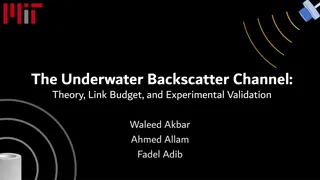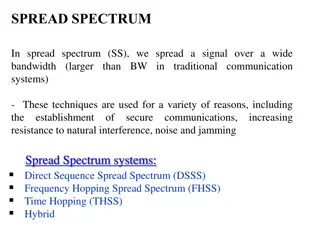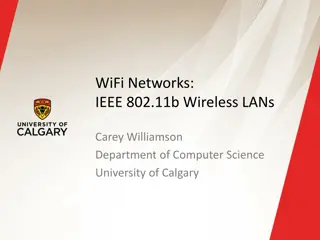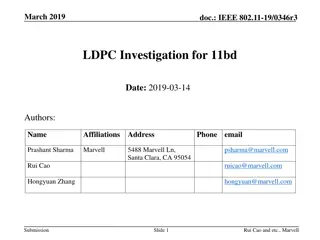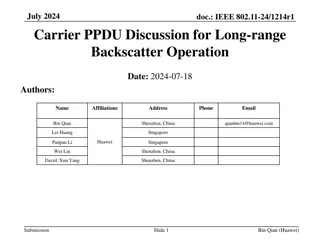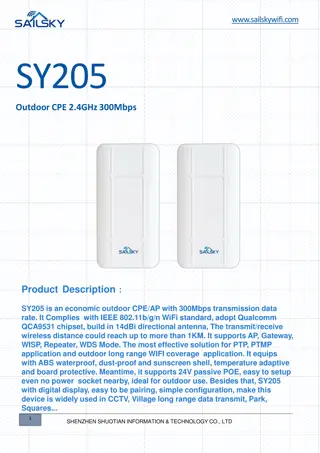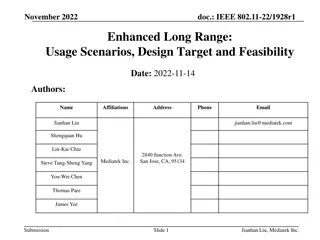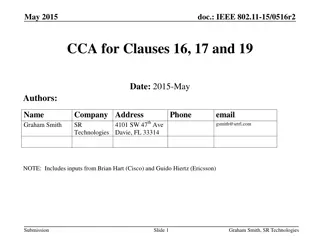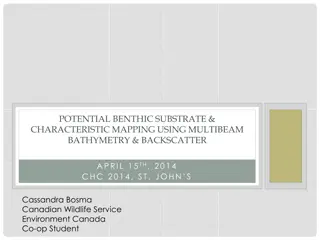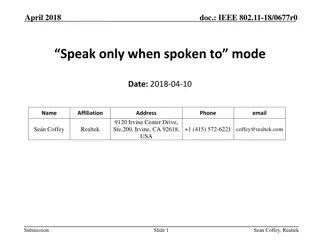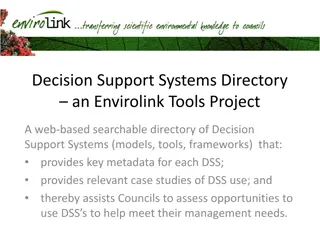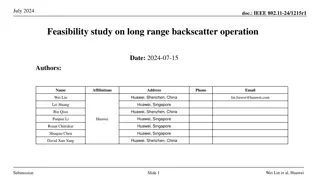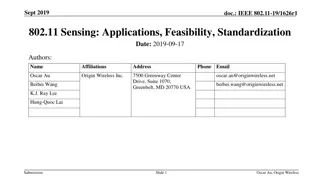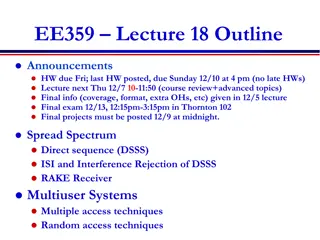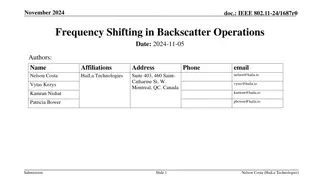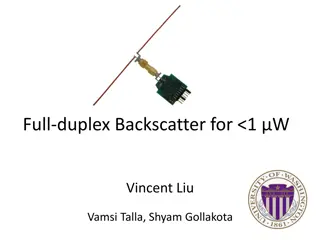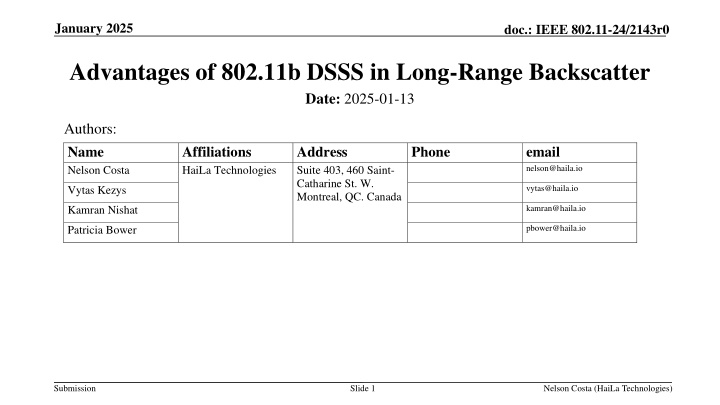
Advantages of Using 802.11b DSSS in Long-Range Backscatter Communications
Explore the benefits of utilizing the 802.11b DSSS waveform for long-range backscatter communications, including increased link margin, improved receiver sensitivity, and enhanced transmission power. Learn how DSSS outperforms OFDM in long-range scenarios, offering significant advantages in range and power efficiency. Discover practical examples and comparisons between DSSS and OFDM waveforms in the context of IEEE 802.11 standards.
Download Presentation

Please find below an Image/Link to download the presentation.
The content on the website is provided AS IS for your information and personal use only. It may not be sold, licensed, or shared on other websites without obtaining consent from the author. If you encounter any issues during the download, it is possible that the publisher has removed the file from their server.
You are allowed to download the files provided on this website for personal or commercial use, subject to the condition that they are used lawfully. All files are the property of their respective owners.
The content on the website is provided AS IS for your information and personal use only. It may not be sold, licensed, or shared on other websites without obtaining consent from the author.
E N D
Presentation Transcript
January 2025 doc.: IEEE 802.11-24/2143r0 Advantages of 802.11b DSSS in Long-Range Backscatter Date: 2025-01-13 Authors: Name Nelson Costa Affiliations HaiLa Technologies Address Suite 403, 460 Saint- Catharine St. W. Montreal, QC. Canada Phone email nelson@haila.io vytas@haila.io Vytas Kezys kamran@haila.io Kamran Nishat pbower@haila.io Patricia Bower Submission Slide 1 Nelson Costa (HaiLa Technologies)
January 2025 doc.: IEEE 802.11-24/2143r0 Abstract Here, we present some advantages of using the 802.11b DSSS waveform in long-range backscatter communications. Submission Slide 2 Nelson Costa (HaiLa Technologies)
January 2025 doc.: IEEE 802.11-24/2143r0 Background In [1], we presented some advantages of using a 1 Mb DSSS waveform in the excitation field to facilitate backscatter modulation. Selectively flipping bits in a BPSK sequence can be done with a simple energy-efficient backscatter transceiver. This technique allows legacy STAs to receive and decode the backscattered frame. This technique avoids the use of purpose-built exciters. Takes advantage of an asymmetrical link: Much of the complexity of forming the PPDU lies with the infrastructure, not the AMP STA. Longer range: 1 Mb DSSS offers the best link budget. 2 Mb DSSS (DQPSK) with shorter preambles is also possible using this architecture. Submission Slide 3 Nelson Costa (HaiLa Technologies)
January 2025 doc.: IEEE 802.11-24/2143r0 Review: DSSS Waveform for Backscatter Operations [2] Take the example where we d like to backscatter a 1 or 2 Mb DSSS frame embedded in the Excitation field of an AMP PPDU. Submission Slide 4 Nelson Costa (HaiLa Technologies)
January 2025 doc.: IEEE 802.11-24/2143r0 Long Range Backscatter: DSSS advantages Over OFDM There are well known advantages of 802.11b 1 Mb, 2 Mb DSSS versus OFDM waveforms, especially in the context of long-range. Typical 3 dB SNR advantage in receiver sensitivity (mostly due to lower rates) Typical 3 4 dB lower PA backoff due to OFDM linearity requirements. (Also implies decreased PA efficiency). More transmit power on the air also equates to more power backscattered. A good 802.11b implementation should have roughly 6-7 dB link margin advantage over OFDM. Results in approximately 40 50% more range in very high pathloss environments. Submission Slide 5 Nelson Costa (HaiLa Technologies)
January 2025 doc.: IEEE 802.11-24/2143r0 11b DSSS Versus OFDM: Practical Example Reference [5] is the data sheet for the Silicon Labs WF200 Network Co- Processor . This is an example of an ultra low power 802.11 b/g/n Wi-Fi transceiver that might be used in IoT applications. With respect to link margin KPIs, the advantages of DSSS over OFDM become especially clear when reviewing these specs. Submission Slide 6 Nelson Costa (HaiLa Technologies)
January 2025 doc.: IEEE 802.11-24/2143r0 11b DSSS Versus OFDM: Practical Example [5] Transmit power for 1 Mb DSSS shows 1.7 dB advantage over 11n (MCS 0). Submission Slide 7 Nelson Costa (HaiLa Technologies)
January 2025 doc.: IEEE 802.11-24/2143r0 11b DSSS Versus OFDM: Practical Example [5] Receive sensitivity for 1 Mb DSSS shows 5.6 dB advantage over 11n (MCS 0). Total link margin advantage DSSS over OFDM: 1.7 + 5.6 = 7.3 dB Submission Slide 8 Nelson Costa (HaiLa Technologies)
January 2025 doc.: IEEE 802.11-24/2143r0 11b DSSS Versus OFDM: Use Case Study In [3], the WFA liaison presented several use case in which non-OFDM (11b) waveforms were advantageous when compared to OFDM waveforms. The use cases of interest to 11bp were Smart home Smart metering Home security In these use cases, the advantages of DSSS over OFDM were found to be Longer ranges, which equates to increased reliability across a wider variety of applications. Lower power consumption. The lower data rates (1 Mb, 2 Mb) were often more than adequate for the applications. This is especially true in many IoT-related applications. Submission Slide 9 Nelson Costa (HaiLa Technologies)
January 2025 doc.: IEEE 802.11-24/2143r0 Conclusion 802.11b DSSS waveforms provide several significant advantages in the context of long-range backscatter. 6 7 dB advantage in link margin (versus OFDM) Simple backscatter architecture lower complexity leads to lower power consumption at the AMP STA Backward compatibility with legacy STAs 802.11b-compatible STAs and APs are widely deployed. 1, 2 Mb DSSS were found by the WFA to be advantageous in IoT applications. Submission Slide 10 Nelson Costa (HaiLa Technologies)
November 2025 doc.: IEEE 802.11-24/2143r0 Straw Polls SP1: Do you agree that to add the following content to TGbp SFD? 11bp defines at least one backscattering mode that supports using 1 Mb and 2 Mb DSSS PPDUs within the Excitation field of an AMP PPDU. Submission Slide 11 Nelson Costa (HaiLa Technologies)
November 2025 doc.: IEEE 802.11-24/2143r0 References [1] Kezys et al., Low Complexity Backscatter AMP STA, 11-24/2002, November 2024. [2] Costa et al., Frequency Shifting in Backscatter Operations, 11-24/1687, November 2024. [3] Stephens, Liaison statement from Wi-Fi Alliance on Non-OFDM Use Cases, 11-14/0905, July 2014 [4] D. Ehichioya, G. Arya, Performance Comparison of OFDM and DSSS on Aeronautical Channels, in International Telemetering Conference Proceedings, Sept. 2009. [Online]. Available: https://repository.arizona.edu/handle/10150/606137 [5] Silicon Labs, WF200 Data Sheet: Wi-Fi Network Co-Processor , December 2018 [Revision 1.1, September 2020]. Available: https://www.silabs.com/documents/public/data- sheets/wf200-datasheet.pdf Submission Slide 12 Nelson Costa (HaiLa Technologies)

![Stakeholders' Responses to National Health Insurance Bill [B.11B-2019]: Overview](/thumb/69945/stakeholders-responses-to-national-health-insurance-bill-b-11b-2019-overview.jpg)
